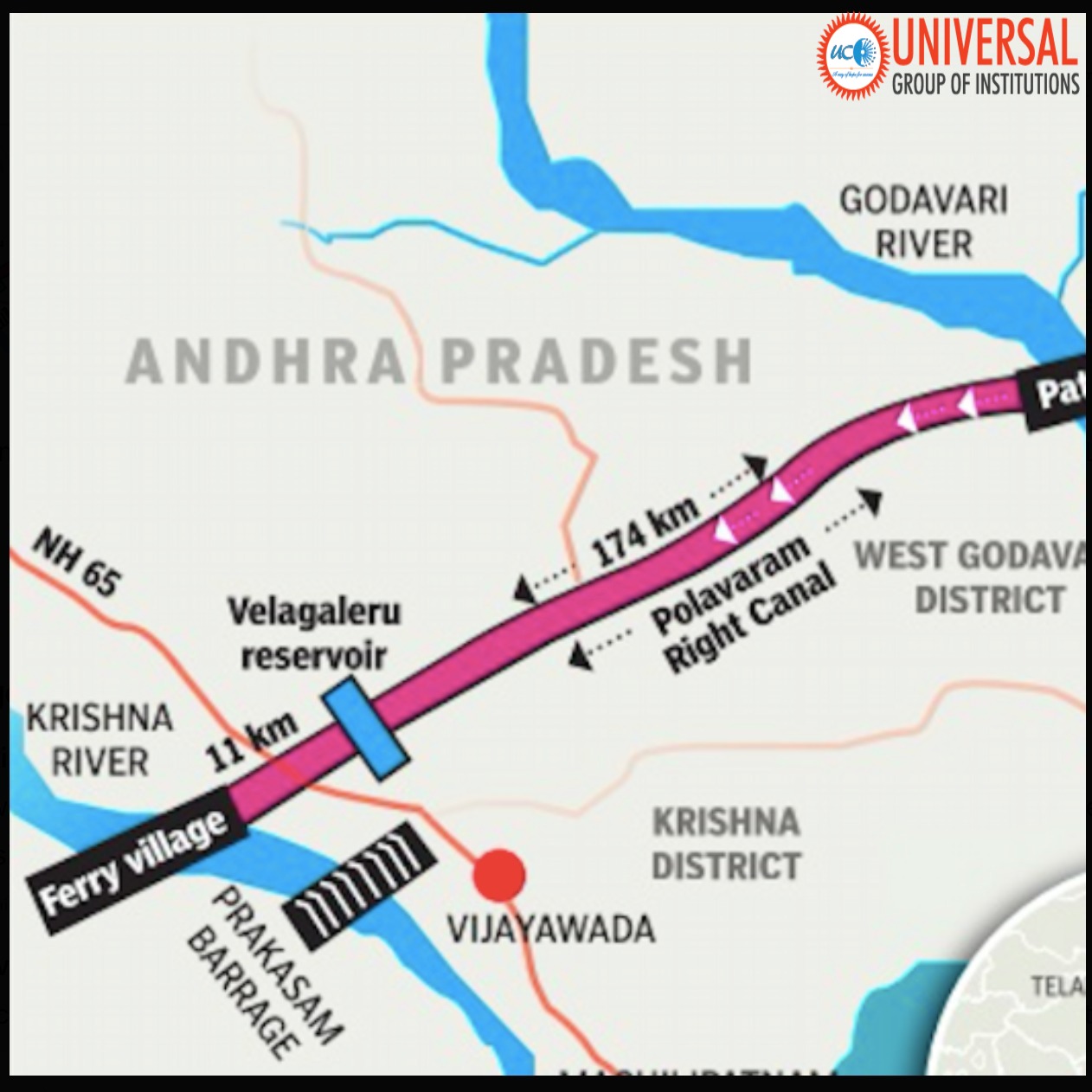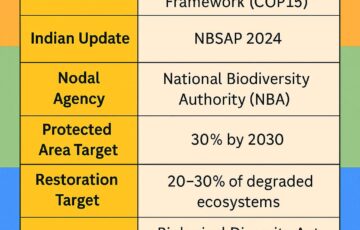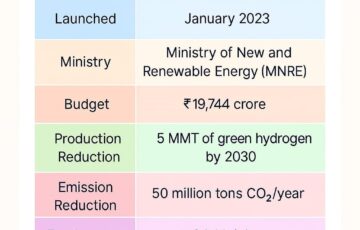Polavaram Project: Developmental Leap or Ecological Gamble?
Polavaram Project: Developmental Leap or Ecological Gamble?
The Government of Andhra Pradesh has officially floated tenders to expedite one of India’s most ambitious interlinking of rivers initiatives—the Godavari-Krishna river linking project, formally known as the Polavaram irrigation project. This project on Godavari river, estimated at ₹81,900 crore, is designed to channel surplus floodwaters from the Godavari River to the drought-prone regions of the Krishna Basin. The Polavaram project benefits include enhancing irrigation potential, stabilizing command areas, and improving drinking water access across Rayalaseema and coastal Andhra Pradesh. The Polavaram project location spans across multiple states, primarily impacting Andhra Pradesh, Odisha, and Chhattisgarh.
Infrastructure Blueprint: Dams, Tunnels, and Lift Systems
The Polavaram project details involve a complex infrastructure framework:
- Polavaram Dam (West Godavari)
- A multipurpose dam that serves as the project’s headworks
- Its reservoir submerges forest and tribal lands in Andhra Pradesh, Odisha, Chhattisgarh, and Telangana
- The Polavaram project gates will control water flow and storage in the reservoir
- Bollapalli Reservoir (Guntur)
- An intermediate balancing reservoir that collects lifted Godavari River water
- Prepares water for tunnel diversion into the Krishna Basin as part of the Godavari-Krishna river linking project
- 24-km Tunnel through Nallamala Forest Hills
- A strategic tunnel that passes through the Eastern Ghats
- Raises serious environmental concerns due to habitat disruption and impact on biodiversity
- Banakacherla Regulator
- Redistributes water into major Krishna basin irrigation systems: KC Canal, SRBC, Velugodu Reservoir, and Tungabhadra Low-Level Canal
- Part of the extensive network of canals, including the Polavaram left canal route
- Multi-stage Lift Irrigation
- Requires heavy electricity usage to elevate water across terrain
- Raises the project’s carbon and fiscal footprint
- Enhances irrigation potential for agriculture in Andhra Pradesh and neighboring states
The Polavaram project map showcases the extensive network of canals and reservoirs spanning across the state, highlighting the project’s ambitious scope in managing water resources and irrigation systems of Andhra Pradesh, Odisha, and Chhattisgarh.
Funding Structure: State, Centre, and Loans
The total Polavaram project budget of ₹81,900 crore will be financed using a Hybrid Annuity Model (HAM) supported by:
- 50% from External Aided Projects (EAPs) through loans
- 20% as grants from the Central Government
- 10% equity from the Andhra Pradesh State Government
- 20% from private sector partners under HAM
The state-run Jalharathi Corporation is the primary Polavaram project contractor responsible for implementation. The central government’s partial support lends credibility, but it has also raised technical and legal concerns through agencies like the Central Water Commission (CWC) and the National Water Development Agency, particularly regarding the interlinking of rivers and its impact on irrigation infrastructure and agriculture in the Godavari-Krishna river linking project.
Strategic Importance and Governmental Roles
The Andhra Pradesh government, led by Chief Minister N. Chandrababu Naidu, views the Polavaram dam as a transformative infrastructure leap. It aims to:
- Drought-proof Rayalaseema
- Reduce over-reliance on Krishna floodwaters
- Maximize Godavari River’s untapped potential for irrigation and hydroelectric power
The Polavaram project capacity is designed to significantly boost the state’s irrigation potential and address water scarcity issues in Andhra Pradesh, Odisha, and Chhattisgarh. The Central Government, while supportive in principle under the National River Linking Project, has flagged feasibility issues related to energy demands, flood control mechanisms, and environmental clearance. Technical scrutiny from national institutions has affected the Polavaram project status, slowing progress on this ambitious project on Godavari river.
Eco-Sensitive Zones Under Threat
The ecological impacts of the Polavaram dam and its reservoir are significant:
1. Nagarjunsagar–Srisailam Tiger Reserve (NSTR)
- Tunnel alignment passes through buffer zones
- Risks disrupting movement of apex predators like tigers and leopards
2. Atapaka Bird Sanctuary (Kolleru Lake)
- Altered hydrology could affect migratory birds like pelicans and storks
3. Papikonda National Park
- Close to Polavaram submergence zone
- Endemic flora and tribal cultures face extinction threats
4. Kolleru Lake Wildlife Sanctuary (Ramsar Site)
- Reduced inflow may lead to wetland degradation and fish species decline
5. Nallamala Forest Range
- Tunnel activity disrupts elephant migration, increases landslide risks
The environmental impact of the Polavaram dam extends beyond these zones, affecting biodiversity and forest rights across the region, including parts of Odisha and Chhattisgarh.
Legal Challenges and Public Sentiment
The Telangana Government has voiced strong opposition to the Godavari-Krishna river linking project, citing violations of the Godavari Water Disputes Tribunal Award and the AP Reorganisation Act, 2014. Telangana argues that Andhra Pradesh failed to obtain consent from riparian states or clearance from the Centre, highlighting the complexities of interstate water sharing in the context of the National River Linking Project.
From a public standpoint, responses to the Polavaram irrigation project are mixed. While farmers and pro-development groups welcome the project for its potential to boost agriculture and irrigation infrastructure, environmentalists, tribal rights activists, and academics have protested against the displacement, loss of biodiversity, and lack of transparent public consultations. In tribal regions affected by the Polavaram dam backwaters, resistance movements have emerged, demanding rehabilitation, recognition, and inclusion in the decision-making process, invoking the Forest Rights Act and the Panchayat Extension to Scheduled Areas Act.
Environmental and Social Impacts
The Polavaram project history is marked by controversy due to its significant environmental and social impacts:
- 40,000+ hectares of forest submerged
- 1.5 lakh tribal people displaced
- High carbon emissions from pump-based lift irrigation systems
- Salinity intrusion in Krishna and Godavari deltas
- Seismic and landslide vulnerabilities in tunneling zones
- Submergence of large areas in Andhra Pradesh, Odisha, and Chhattisgarh
These impacts have raised questions about the long-term sustainability of such large-scale dam construction and irrigation projects, particularly their effects on local biodiversity and agriculture. The Polavaram project gates, designed to control water flow, will play a crucial role in managing the reservoir levels and irrigation supply for the Godavari-Krishna link.
Global Context and Learning from Ken–Betwa
Similar to India’s Ken–Betwa Link, where the Panna Tiger Reserve was at risk, this Godavari-Krishna river linking project must heed lessons from global river-diversion efforts like China’s South-North Transfer Project, which sparked irreversible ecological shifts. A sustainable model for the Polavaram dam must prioritize ecological flow, wildlife protection, and climate resilience, balancing the needs of agriculture and water storage with environmental conservation.
As the Polavaram project completion date approaches, it remains a contentious topic in the broader discourse on the interlinking of rivers in India. The project exemplifies the challenges and opportunities inherent in large-scale water management initiatives, highlighting the need for a balanced approach that considers both developmental needs and ecological preservation. The Polavaram dam, with its extensive network of canals and reservoirs, stands as a testament to India’s ambitious irrigation and water transfer goals, while also serving as a focal point for debates on sustainable development and environmental stewardship in the context of the Godavari-Krishna link project.
The Polavaram dam’s reservoir will play a crucial role in water management and irrigation for Andhra Pradesh, Odisha, and neighboring states. However, the project’s impact on existing irrigation systems and the need for new irrigation infrastructure to fully utilize the increased water availability pose significant challenges. As the Godavari-Krishna river linking project progresses, careful consideration must be given to balancing the benefits of enhanced irrigation potential with the environmental and social costs associated with such a massive undertaking in the Godavari River basin.









